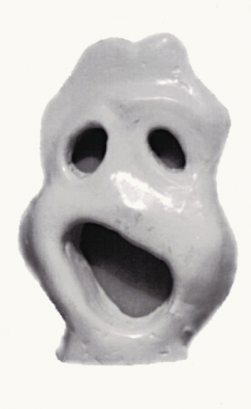| Umělec magazine 2003/2 >> Jakub Staněk | List of all editions. | ||||||||||||
|
|||||||||||||
Jakub StaněkUmělec magazine 2003/201.02.2003 Jiří Ptáček | new faces | en cs |
|||||||||||||
|
Born 1972, autodidact. In 2000, became founding member of Skupina 0000 in Třebíč.
We would probably know Jakub Staněk as an experienced conceptual artist, if it weren’t for his constant efforts to stand on the edge of art history, to supplement it with unexpected raids while remaining as far out on the periphery as he can go. As early as the first half of the 1990s, he began to attack the inhabitants of Třebíč with his handmade posters in which he touches on the uncongeniality of the social changes of those days and the memory of the town. Concentrating on the local effects of artistic creation brought him closer to his contemporaries from the future Skupina 0000 (Daniela Loucká, Lubomír Konrat, Pavel Ryška). At the close of the 1990s and into the new century, however, he sharpened his focus towards the discovery of creative art’s social coherence. With a bird’s eye view he fell into the ranks of persiflage in post-modern citations, in order to discover Pollock’s dripping in bespattered work clothes and the face of the figure from Edvard Munch’s picture The Scream in vials of consecrated water. In any case, found objects should not widen our notion of what can be considered as art, but rather to non-violently manipulate the image of the intersections of modern art with the commonest realities. If Staněk later turned mainly to three-dimensional forms, they led him especially to the desire of trying modernist morphology as a people-meter of today’s esthetic priorities. Small, patina-covered, “Zadkinesque” figurative reliefs seem as if he has returned to the scene represented by the fallen communal creation of the Dílo chain store in the 70s and 80s. An added value in Jakub Staněk’s work is the manifest carelessness of execution. In principle, however, it is not a question of the form of individual works, but of the rotating centrifuges of the spectators’ reaction, which, despite the evident impotence of the artist, remained enthusiastic. This series is closing down for the time being, and he is currently oriented towards his soap piece, Two Old Women on a Balcony, whose minimalist Plexiglas shelves jar with an ill-favoured quasi-physical appearance, after the example of Martin Gober. This time Staněk’s viewfinder finds a notional district, except that the wholesale submission of models of decentralized artistic creations and the uncritical vision of alienation from the self corresponds to high art. Munch’s Scream became for Staněk the stimulus for his recent performances. This icon of all expressive tendencies of the 20th century should be tested to see whether it is endorsed by an imaginative framework of strong or weak signs, and whether it can cause déja vu. The intellectually grasped expressions of Jakub Staněk are beginning to exceed local limits, as they increasingly engage with the character of western art history, its constructs and impact. Jiří Ptáček The Scream after One Hundred and Nine Years 13th and 14th June 2002 I studied the central figure of Munch’s picture The Scream. I was most interested in the elliptical shape of the mouth. I deduced that the scream originally consisted of the voicing of the repeated vowel O. At noon I cut my hair a lot, dressed in black overalls and went to town. I went into a self-service shop and adopted a position cribbed from Munch’s picture. I repeated the scream next to the shelf filled with candy. I hoped that my scream would end in loud wonder above the wide assortment of sweets. My second scream was in a dentist’s waiting room. On the second day I screamed at the railway station at the moment when the train was pulling out and people inside could observe me from their compartments. Perhaps I looked like a person who had left his luggage on the train, but maybe I only caused speculation as to what could have happened to make me misbehave like that. As usual, I did not supply documentation. A bare artistic gesture could undermine my real aim, which was to observe the various reverberations of people in terror expressed under different conditions. The Scream as a Viscous Field 1st January 2003 On the first day of the new year the group met for an improvised exhibition called “OŠP” [Opět Špatná Předsevzetí or Eng: Another Bad Resolution — ed.]. I made eight eyes and four mouths from wax on a table-top in advance. In front of my colleagues I poured a carton of milk onto the table. It trickled from the waxed areas and four screams appeared on the table-top. Intervention: The Scream as a Product of the Land (together with Daniela Loucká) April 20 – July, 2003 On a working day, Daniela Loucká and I climbed over the fences of three gardens in an allotment area. We found carrots growing in beds. From each bed we pulled up several young carrots and with a knife we gouged out eyes and mouths according to the image in Munch’s The Scream. Then we replanted the carrots. Afterwards, Daniela checked the local press each day to see whether it contained any mention of the gardeners’ strange crop. Because nothing appeared there, we judged that the gardeners had overlooked the special carrots, or had kept the secret of their fearful faces to themselves. Doubt about The Scream While thinking up new applications for Munch’s Scream I began to have doubts about whether the painting can be perceived acoustically. A silent spasm seems more appropriate to me. Night, 25 August 2003 (Jakub Staněk: “Considerations of Spilt Milk,” notes from the years 2000 – 2003)
01.02.2003
Recommended articles
|
|||||||||||||












Comments
There are currently no comments.Add new comment